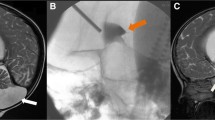Abstract
Purpose:
To investigate in a prospective randomized study setting if increased signal intensity of the cerebrospinal fluid (CSF) on fast FLAIR images is caused by high oxygen concentrations or anesthetic agents used during general anesthesia.
Patients and Methods:
40 children (13 females/27 males) aged 3 months to 8 years were included. The study was approved by the ethics committee of the authors' institution. Parents gave written informed consent to participation of their children. Patients were randomly allocated to one of four different anesthesia techniques: sevoflurane plus 30% oxygen, sevoflurane plus 100% oxygen, propofol plus 30% oxygen, and propofol plus 100% oxygen. Hard copies of the FLAIR sequence were used for blinded analysis of the signal intensity of the subarachnoid space.
Results:
No significant difference in signal intensity of the CSF was detected between anesthesia with propofol or sevoflurane irrespective of using 30% or 100% oxygen during anesthesia. On the other hand, signal intensity of the CSF was increased when sevoflurane or propofol was combined with 100% inhaled oxygen. The difference of the CSF signal intensity was most pronounced over the cerebral convexities (p < 0.005) but was also observed in the basal cisterns.
Conclusion:
Hyperintense signal in the subarachnoid space can result from supplemental oxygen during anesthesia. To avoid misdiagnosis such as subarachnoid hemorrhage, purulent meningitis or meningeal carcinomatosis, radiologists should be aware of the phenomenon of increased cerebrospinal fluid signal intensity on T2-weighted FLAIR images caused by supplemented oxygen.
Zusammenfassung
Ziel:
In einer prospektiven, randomisierten Studie soll untersucht werden, ob das erhöhte Liquorsignal auf T2-gewichteten FLAIR-Bildern während einer Allgemeinnarkose durch erhöhte inspiratorische Sauerstoffkonzentration oder Anästhetika verursacht wird.
Patienten und Methodik:
40 Kinder (13 Mädchen, 27 Jungen) im Alter von 3 Monaten bis 8 Jahren wurden in die Untersuchung eingeschlossen. Die Studie wurde von der lokalen Ethikkommission genehmigt. Die Eltern gaben die schriftliche Zustimmung zur Teilnahme ihrer Kinder an der Untersuchung. Die Kinder wurden einer von vier Narkoseformen randomisiert zugeteilt: Sevofluran plus 30% Sauerstoff, Sevofluran plus 100% Sauerstoff, Propofol plus 30% Sauerstoff und Propofol plus 100% Sauerstoff. Von der FLAIR-Sequenz wurden Hardcopies ohne Patientenspezifikation angefertigt und geblindet bezüglich der Intensität des Liquorsignals ausgewertet.
Ergebnisse:
Es ergab sich keine signifikante Differenz des Liquorsignals zwischen Narkosen mit Propofol und Sevofluran, unabhängig vom verwendeten Sauerstoffgehalt (30% vs. 100%). Andererseits war ein hyperintenses Liquorsignal festzustellen, wenn Sevofluran oder Propofol mit 100% Sauerstoff kombiniert wurde. Die Differenz des Liquorsignals war über den zerebralen Hemisphären am ausgeprägtesten (p < 0,005), aber auch basal nachweisbar.
Schlussfolgerung:
Bei der T2-gewichteten FLAIR-Sequenz kann ein hyperintenses Signal im Subarachnoidalraum durch erhöhte Sauerstoffkonzentration während der Narkose entstehen. Radiologen sollten das Phänomen des hellen Liquors in der T2-gewichteten FLAIR-Sequenz durch erhöhte Sauerstoffkonzentration in der Inspirationsluft kennen, um Verwechslungen mit Subarachnoidalblutung, eitriger Meningitis oder Meningeosis carcinomatosa zu vermeiden.
Similar content being viewed by others
Author information
Authors and Affiliations
Corresponding author
Rights and permissions
About this article
Cite this article
Goetz, G.F., Hecker, H., Haeseler, G. et al. Hyperintense Cerebrospinal Fluid on FLAIR Images Induced by Ventilation with 100% Oxygen. Clin Neuroradiol 17, 108–115 (2007). https://doi.org/10.1007/s00062-007-7011-7
Received:
Accepted:
Issue Date:
DOI: https://doi.org/10.1007/s00062-007-7011-7




